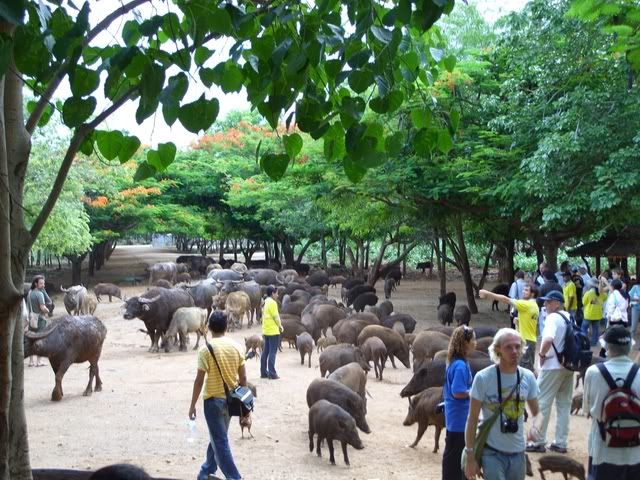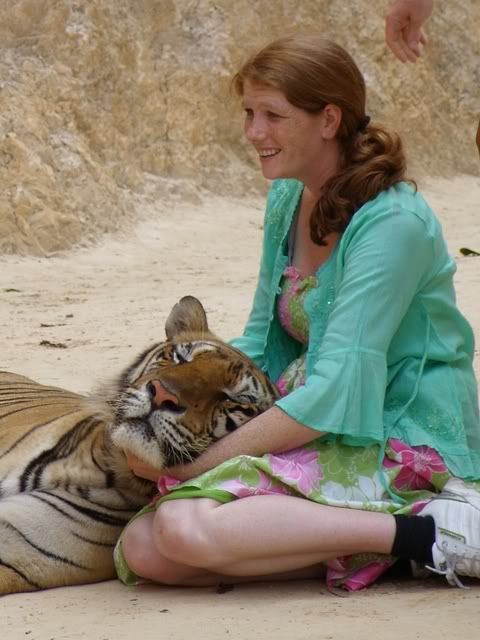Tiger Temple in Kanchanaburi
HOW DID THESE TIGERS COME? -from www.tigertemple.org
 "Wat Pa Luangta Bua Yannasampanno Forest Monastery was established by the Abbot-Phra Acharn Phusit (Chan) Kanthitharo in 1994.
"Wat Pa Luangta Bua Yannasampanno Forest Monastery was established by the Abbot-Phra Acharn Phusit (Chan) Kanthitharo in 1994.
Since its opening Wat Pa Luangta Bua gained a reputation as a wildlife sanctuary. It started with an injured wild fowl given to the monk by the villagers, then peacocks came attracted by the calls of by then rather large colony of wild fowl. An injured wild boar stumbled in to the monastery and the monks cared for him until he could be released back into the forest. The next day he came back followed by his family group of about 10 animals. By now a countless number of boar find shelter in the monastery. Villagers also started to bring in unwanted pets: four species of deer moved in, followed by buffalo, cow, horses, wild goat and gibbons. All these animals are roaming the grounds of the monastery freely.
The first tiger cub arrived to the monastery in February 1999. It was a female cub of Indochinese subspecies (Tigris corbetti) and her condition was very poor. When she was only a few months old her mother was killed by poachers near the Thai-Burma border. The cub was sold to and the new owner ordered her stuffed. A local was hired to do the job, which fortunately he did not finish. Although he injected her in the neck with the preservative formalin the cub survived. When she arrived to the to the monastery she was frail and terrified of a slightest sound. She still has stitches in the cuts on her head. Her vision was impaired and her teeth were already worn, particularly the fangs, which appeared as if they have been filed down to the gum, blood oozing from the roots. Eating was a difficult task for her - she could hardly move her tongue, chew and swallow her food. In spite of her condition she has never once attacked anyone. Under loving care of the monks the cub recovered, but in July 1999 she fell seriously ill with heart palpitations and died.
People who knew about the incident did not want to see another cub mistreated again. However it was not to be. The monastery is situated in Kanchanaburi province - an area lying adjacent to Burma. Large protected areas and national parks along the Thai-Burma border are believed to contain the largest surviving populations of tigers in Thailand. Unfortunately, while these areas are protected poaching still occurs. A Thai poacher can get up to US $5,800 for killing a tiger, several years' salary to a farmer. The profit is well worth the risk. And when the mother tiger is killed the cubs are taken as a bonus, or left to fend for themselves in the jungle.
Just a few weeks after the first cub has died two healthy male cubs, intercepted from the poachers, were brought to the monastery. They were tiny - just a week old. A few months later the local villagers presented another two male cubs. And soon after the border police patrol intercepted cubs held by poachers and contributed four female cubs, achieving tiger harmony.
The Abbot, Phra Acharn Chan, kindly welcomed the animals. And so the monks ended up looking after the orphaned cubs. None of them had any training in how to handle tigers. They had to learn on the job.
The monastery did its duty. It became a sanctuary and it upholds the sanctity of compassion and kindness to all living creatures."
And some pictures from our exciting day!Me with one very large guy:

A great picture of mom...looks like the tiger's smiling too!

Feeding time at the temple:

Me and Ot before the temple:

Lovely picture on Amy with a tiger in her lap:


2 Comments:
At 9:35 PM , Hilary said...
Hilary said...
aw amy! this is the first time i've seen her looking a bit timid :)
At 10:45 PM , Unknown said...
Unknown said...
Oh that's pretty awesome. I really enjoyed getting to sit with the tigers too...though I was totally (and unreasonably) expecting them to be soft like house cats rather than bristly.
Also, I miss you a lot. I've been thinking about Thailand and about possibly going back in a more independant fashion.
Post a Comment
Subscribe to Post Comments [Atom]
<< Home